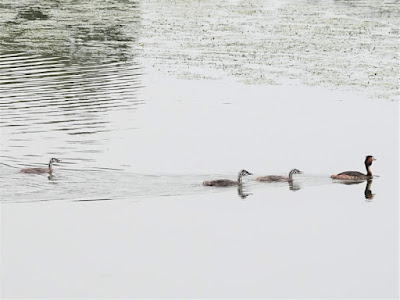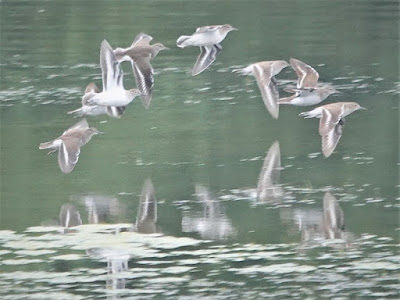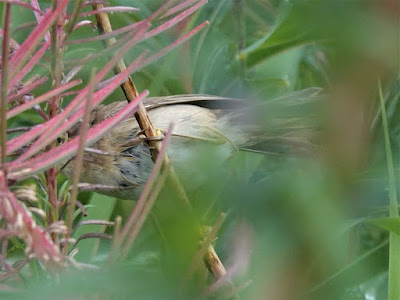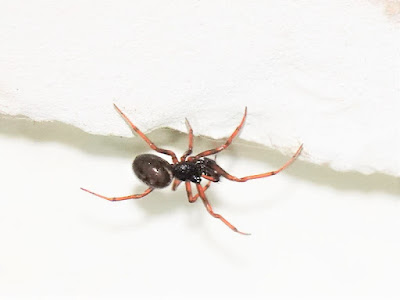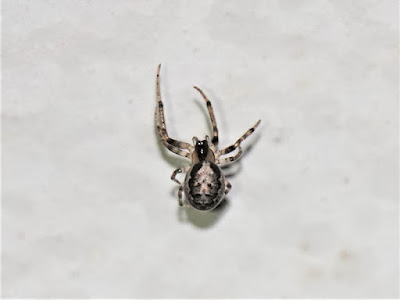12.0°C > 14.0°C: Overcast with spells of rain and / or drizzle. Almost calm. Mostly good visibility.
Sunrise: 05:25 BST
* = a species photographed today
$ = my first sighting of the species for this year
$$ = my first ever recorded sighting of the species in the area
Priorslee Balancing Lake: 05:15 – 06:25 // 07:30 – 09:35
(185th visit of the year)
A rain delayed start and a rain affected set of numbers.
Bird notes
Highlight today was seeing an eventual total of 11 Common Sandpipers together. I cannot recall such a large gathering of this species here on Autumn passage previously. In the past I have certainly noted double figures in Spring. Also I recall a party of, I think, 15, dropped in momentarily at The Flash where they are not common, especially in Autumn. At 05:30 while standing on the concrete slipway checking the birds on the south-west grass I could hear Common Sandpiper calls apparently high overhead. I could not see any but two birds suddenly appeared on one of the boat launching platforms. It was only later on my second lap that I flushed all eleven. I am pleased to say they all settled back down.
Other bird notes:
- just one Greylag Goose when I arrived. Again I am not sure any geese had over-nighted. Birds were later than usual arriving and I noted 48 Canada Geese and three Greylag Geese present. After I had departed from the immediate lake area I heard more geese arriving.
- no obvious Mallard ducklings were noted.
- the duck Pochard gone / hiding!.
- as yesterday four juvenile Great Crested Grebes noted. Two adults were displaying rather half-heartedly at the West end where there does not seem to have been a nest this year. If there was then no young were noted.
- as in several recently a second Grey Heron has arrived and landed on one of the buoys. It seems so long as it stays there the other bird is unconcerned.
- my slightly delayed arrival probably meant I was too late to see the main groups of Jackdaws flying over, outbound from their roosts.
- the weather dampened birds enthusiasm to sing. No song from the Blackbird was heard: neither were any of the Song Thrushes or warblers singing.
- a male Common Whitethroat was with other warblers at the West end.
Bird(s) noted flying over here:
- 31 Canada Geese: 23 outbound in three groups; eight inbound in three groups
- 28 Greylag Geese: 18 outbound in four groups; 10 inbound together
- 2 Mallard: singles
- 169 Wood Pigeons
- 1 Collared Dove
- 1 Lesser Black-baked Gull: fly-overs unusual
- 1 Herring Gull once more
- 2 Lesser Black-baked Gulls
- 35 Jackdaws
- 91 Rooks
Counts from the lake area:
- 48 Canada Geese: see notes
- 3 Greylag Geese: see notes
- 2 Mute Swans
- 22 (♂?) Mallard: see notes
- no Pochard
- 11 + 3 (2 dependent broods) Moorhens
- 112 Coots: another new brood (of two?) noted
- 7 + 4 (2 broods) Great Crested Grebes: see notes
- 11 Common Sandpipers
- 9 Black-headed Gulls: no juveniles
- 7 Lesser Black-baked Gulls
- 2 Grey Herons: one arrived
Hirundines etc. noted:
None
As a postscript to my notes yesterday suggesting an early departure by the local Swifts I can add that only a very few birds remain around their Newport haunts.
Warblers recorded (the figure in brackets is birds noted singing):
- 1 (0) Cetti's Warbler
- 1 (0) Willow Warbler
- 12 (0) Chiffchaffs again
- 9 (0) Reed Warblers
- 4 (0) Blackcaps again
- 1 (0) Common Whitethroat
Noted on the West end street lamp poles around-dawn:
As a postscript to my notes yesterday suggesting an early departure by the local Swifts I can add that only a very few birds remain around their Newport haunts.
Warblers recorded (the figure in brackets is birds noted singing):
- 1 (0) Cetti's Warbler
- 1 (0) Willow Warbler
- 12 (0) Chiffchaffs again
- 9 (0) Reed Warblers
- 4 (0) Blackcaps again
- 1 (0) Common Whitethroat
Noted on the West end street lamp poles around-dawn:
Moths:
- none
- none
Spiders, harvestmen etc.:
- 3 Bridge Orb-web Spiders Larinioides sclopetarius
- 2 harvestmen Leiobunum blackwalli / rotundum
Noted later:
Very little noted in rain and wet vegetation
- 3 Bridge Orb-web Spiders Larinioides sclopetarius
- 2 harvestmen Leiobunum blackwalli / rotundum
Noted later:
Very little noted in rain and wet vegetation
Butterflies:
none
none
Moths
4 Straw Grass-moth Agriphila straminella [was Straw Grass-veneer]
4 Straw Grass-moth Agriphila straminella [was Straw Grass-veneer]
Bees, wasps etc.:
Common Wasp Paravespula vulgaris
Common Wasp Paravespula vulgaris
Hoverflies:
none
none
Dragon-/Damsel-flies:
none
none
Four-winged flies – Lacewings, Caddisflies etc.:
none
none
Other flies:
only unidentified fly species
only unidentified fly species
Bugs etc.:
none
none
Beetles:
7 Spot Ladybird Coccinella 7-punctata
7 Spot Ladybird Coccinella 7-punctata
Spiders, harvestmen etc.:
none
none
New plants for the year:
None
And here seven with the one in the middle (Paul Jones? 1960s pop reference. My era) giving a top-side plan view.
It was another day for photographing warblers. They were probably motivated out of the deepest cover by the wet vegetation. The strength of the eyebrow (supercilium) identifies this as a Willow Warbler.
A Blackcap. With a brown cap this could be a female or a juvenile of either sex though juvenile males usually grow a few black feathers before they fly off to sub-Saharan Africa for our Winter.
This species has a much thicker bill than many warblers and is more omnivorous. It especially likes Blackberries in the Autumn. It will have to be quick this year. I ate my first wild blackberry on 01 July, a full two weeks ahead of normal.
...a juvenile. Note the gape line and the pale tips and fringes to its new adult feathers. These will abrade during the rest of the year.
(Ed Wilson)
In the Priorslee Avenue tunnel:
A dreaded Box-tree Moth Cydalima perspectalis: my first in Shropshire. First recorded in the UK in 2007 and the West Midlands in 2017 this is an invasive species that originates from East Asia. It was likely accidentally imported as larvae in with Box Buxus plants as part of the horticultural trade. The larvae often destroy all the leaves of Box plants in many parts of the UK. It may be the only reason to welcome the Yellow-legged Asian Hornet Vespa velutina to out shores as it is thought this predator controls the natural Asian population of the moth. [Not really: the hornet could wipe out our native bees]. Despite the moth's very different appearance it is closely related to our grass moths.
This is possibly a Rabbit Hutch Spider Steatoda bipunctata according to Obsidentify. It does have the white crescent at the front of the abdomen shown by spiders in this genus. None of the photos on the web show such red legs though.
(181st visit of the year)
Bird notes:
- no Mallard ducklings seen again
- *four adult Great Crested Grebes again. I managed to see one juvenile on the back of one bird from the pair at the top end. I also confirmed that the pair by the island still have three juveniles.
Bird(s) noted flying over here:
- 1 Jackdaw
Noted on / around the water:
- 13 Canada Geese
- 3 Greylag Geese
- 6 Mute Swans
- 23 (?♂) Mallard
- 13 (?♂) Tufted Duck
- 7 Moorhens
- 84 + 5 (4 dependent broods) Coots:
- *4 + 4 (2 broods) Great Crested Grebes: see notes
- 5 Black-headed Gulls: no juveniles
Hirundines etc. noted:
An adult Great Crested Grebe with three juvenile humbugs.
All eleven Common Sandpipers in flight – there is a laggard at the extreme right.
Eight (nine I suspect) reflecting in the lake.
All eleven at rest.
I still think it is a clever trick of the Grey Heron to balance on a buoy like this. It always seems to do so with its neck stretched out – to help its balance? So long as it stays on the buoy the other Grey Heron leaves it alone. Note two Common Sandpipers flying by.
It was another day for photographing warblers. They were probably motivated out of the deepest cover by the wet vegetation. The strength of the eyebrow (supercilium) identifies this as a Willow Warbler.
And again. Note the dark bill.
A Chiffchaff showing its thinner and paler bill.
Not such a good view as yesterday of a Reed Warbler!
"I'm coming to get you!" Not enough light to freeze the action.
A splendid Common Whitethroat in the rain.
Again. Looking round-shouldered here.
It was not just warblers I noted sitting around in the rain. Here is a Song Thrush...
Also a moulting Robin.
(Ed Wilson)
------------------------------------------------------------------------------------------------------
In the Priorslee Avenue tunnel:
Moths: [36 species here before today; one (unwelcome) addition [one ID still pending]]
1 Box-tree Moth Cydalima perspectalis: my first in Shropshire
I had hoped for more sheltering from the rain...
1 Box-tree Moth Cydalima perspectalis: my first in Shropshire
I had hoped for more sheltering from the rain...
Flies:
6 moth flies Psychodidae sp. [Drain Fly or Owl Fly]
11 midges of various species.
6 moth flies Psychodidae sp. [Drain Fly or Owl Fly]
11 midges of various species.
Arthropods:
4 White-legged Snake Millipedes Tachypodoiulus niger
4 White-legged Snake Millipedes Tachypodoiulus niger
Spiders, harvestmen etc.:
1 possible Rabbit Hutch Spider Steatoda bipunctata
2 Missing Sector Orb-web Spiders Zygiella x-notata [Silver-sided Sector Spider]
other spiders not identified
1 harvestman Opilio canestrinii
1 possible Rabbit Hutch Spider Steatoda bipunctata
2 Missing Sector Orb-web Spiders Zygiella x-notata [Silver-sided Sector Spider]
other spiders not identified
1 harvestman Opilio canestrinii
A dreaded Box-tree Moth Cydalima perspectalis: my first in Shropshire. First recorded in the UK in 2007 and the West Midlands in 2017 this is an invasive species that originates from East Asia. It was likely accidentally imported as larvae in with Box Buxus plants as part of the horticultural trade. The larvae often destroy all the leaves of Box plants in many parts of the UK. It may be the only reason to welcome the Yellow-legged Asian Hornet Vespa velutina to out shores as it is thought this predator controls the natural Asian population of the moth. [Not really: the hornet could wipe out our native bees]. Despite the moth's very different appearance it is closely related to our grass moths.
A Missing Sector Orb-web Spider Zygiella x-notata with a glint in two of its eight eyes – the camera flash. Do I really need to use "red eye" setting on insects?
(Ed Wilson)
The Flash: 06:30 – 07:25
(Ed Wilson)
------------------------------------------------------------------------------------------------------
The Flash: 06:30 – 07:25
(181st visit of the year)
Bird notes:
- no Mallard ducklings seen again
- *four adult Great Crested Grebes again. I managed to see one juvenile on the back of one bird from the pair at the top end. I also confirmed that the pair by the island still have three juveniles.
Bird(s) noted flying over here:
- 1 Jackdaw
Noted on / around the water:
- 13 Canada Geese
- 3 Greylag Geese
- 6 Mute Swans
- 23 (?♂) Mallard
- 13 (?♂) Tufted Duck
- 7 Moorhens
- 84 + 5 (4 dependent broods) Coots:
- *4 + 4 (2 broods) Great Crested Grebes: see notes
- 5 Black-headed Gulls: no juveniles
Hirundines etc. noted:
None
Warblers recorded (the figure in brackets is birds noted singing):
- 6 (1) Chiffchaffs
- no Blackcaps
Noted around the area:
Nothing seen apart from:
Warblers recorded (the figure in brackets is birds noted singing):
- 6 (1) Chiffchaffs
- no Blackcaps
Noted around the area:
Nothing seen apart from:
Hoverflies:
*1 unidentified hoverfly asleep on a street lamp pole
*1 unidentified hoverfly asleep on a street lamp pole
Spiders, harvestmen etc.:
10 harvestmen Dicranopalpus ramosus/caudatus
1 harvestman Opilio canestrinii
An adult Great Crested Grebe from the top end with one juvenile humbug visible on its back. The adult seems to have a growth on the side of its face.
The other Great Crested Grebe family with one juvenile falling / climbing off the parent's back and two other humbugs in the water.
I am beaten to identify this hoverfly, asleep on one of the street lamp poles. It cannot be a Syrphus species as the scutellum (the half-moon area behind the thorax) is not yellow. All the other suggestions from the apps point to species that are either more narrowly-built; have spots that are white(ish) rather than yellow; or with the orientation of the uppermost spot angled differently. Drat.
(Ed Wilson)
2006
Priorslee Lake
1 Common Tern
(Ed Wilson)
10 harvestmen Dicranopalpus ramosus/caudatus
1 harvestman Opilio canestrinii
Same adult. Good at concealing however many humbugs there are.
(Ed Wilson)
------------------------------------------------------------------------------------------------------
2006
Priorslee Lake
1 Common Tern
(Ed Wilson)
